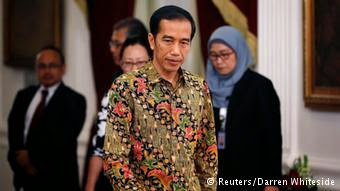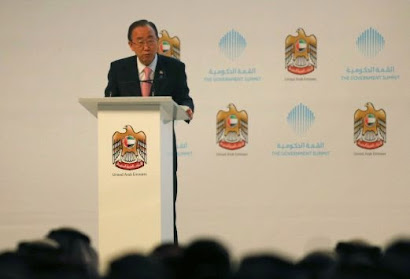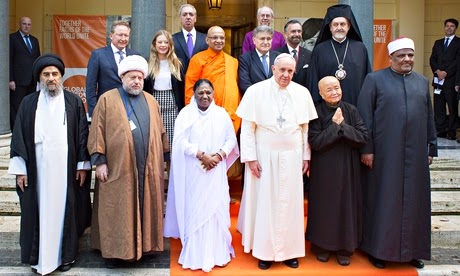Jakarta Globe, Nadia Bintoro, Mar 20, 2015
 |
| The artist Made Bayak wants to raise awareness about the unsustainable use of plastic in Bali, through his project to build an ogoh-ogoh for Nyepi the traditional way. (JG Photos/Nadia Bintoro) |
As Hindus
in Bali prepare to mark the sacred day of Nyepi, or the Day of Silence, that falls this Saturday, myriad
spooky-looking monster effigies, known as ogoh-ogoh, have begun popping up in villages across the island.
Nyepi marks
the start of the New Year in the Balinese Saka calendar, and as such is the
most important religious celebration for the island’s Balinese faithful. The
celebrations leading up to the day begin with the purification ceremony of
Melasti, which takes place three to four days before in a temple by the sea,
culminating on the eve of Nyepi with the burning of the ogoh-ogoh.
A
representation of evil spirits, ogoh-ogoh are larger-than-life effigies of
demons, symbolizing negative elements or malevolent spirits. During the Bhuta
Yajna ritual, on the night before Nyepi, the ogoh-ogoh are paraded around each
village and then set alight, in a symbolic act of vanquishing all negative
elements and restoring the balance between the gods, mankind and nature.
It
represents a total cleansing before welcoming Nyepi, a day reserved for
self-reflection, when all activities that may hinder such purpose are
prohibited. As such, there is no lighting of fires, no working, no
entertainment activities and no traveling during Nyepi, with Bali’s airport shut
down for the day.
In the
past, ogoh-ogoh were made from bamboo and paper. In recent years, though, the
artisans who make them have increasingly turned to the more pliable medium of
Styrofoam — a choice of convenience, but one that goes against the meaning of
Nyepi as a day for getting back in balance with nature.
Local
artist Made Bayak is leading a small revolution to take the ogoh-ogoh back to
its environmentally conscious roots. He does this by constructing his ogoh-ogoh
from plastic waste, to symbolize the true evils that have engulfed the resort
island in recent years.
An
artist-cum-environmental activist, Bayak hails from Banjar Sakih ward in
Gianyar district, and studied at the Indonesia Institute of Arts in Denpasar.
In his
third year there he began experimenting with art using plastic as his medium.
He went on to exhibit the resulting works in a show titled “Plastiliticum,” an
indictment of the “age of plastic” in which he says mankind has mired itself.
“I believe
that after the megalithic and paleolithic, mankind is entering the new era of
Plastiliticum,” Bayak says.
“If we
continue consuming plastics like we do, archaeologists in the future will only
dig up plastic as the remnants of our civilization.”
Bayak’s
“Plastiliticum” expanded over the years and is now a project titled
“Plasticology,” which the artist has been working on for the past five years.
The project
has yielded numerous works of art, from paintings to statues, that employ
plastic waste and other castoffs that Bayak collected himself from landfills.
To mark
Nyepi this year, Bayak is challenging himself to extend the “Plasticology”
theme by incorporating an important cultural celebration into his art to create
an even bigger momentum in his push for greater awareness.
“Creating this ogoh-ogoh along the youngsters
in my village is my way of campaigning against the trend of making ogoh-ogoh
using Styrofoam,” he says.
“It is also
a way of educating the youngsters on the dangers of Styrofoam, which releases a
toxic smoke when it burns. Even during the sculpting process, the fine Syrofoam
grains can be very dangerous if inhaled by the artists.”
Through his
ogoh-ogoh, Bayak is also declaring war on the culture of instant gratification
that pervades life in Bali in the contemporary age.
“It seems
everybody in Bali nowadays is so caught up with the instant lifestyle. They
want everything to come quick and easy, and forget about the real essence of
the making of ogoh-ogoh,” he says.
“Ogoh-ogoh
is essentially a symbol of Bhutakala or the bad traits that people possess.
During the Tawur Kesanga ceremony on the night before Nyepi, when people burn
the ogoh-ogoh, there’s a term, ‘nyomia,’ which is about turning the traits of
Bhutakala into God’s traits.
“So it’s
about salvation and how to make something that’s bad good again. This is what I
want to achieve with the use of plastic waste in making this ogoh-ogoh. It’s
recycling through culture, as I believe Styrofoam and plastic are just another
form of the evil Bhutakala.”
With the
help of his four nephews and local youths, Bayak is rushing to finish his
ogoh-ogoh before Nyepi. The frame is constructed out of bamboo, the body will
be padded out with papier-mache using old newspapers, while plastic waste will
be used for the outer embellishments and for adding color.
“The
challenge was to find the right plastic rubbish to create the artistic coloring
that I envision for the surface. I had to visit a lot of landfills in Bali to
dig up these treasures,” Bayak says.
He says he
hopes this practice of re-using plastic waste will catch on among the people
who turn out to watch the ogoh-ogoh parade and the subsequent burning tonight.
Bayak also
continues to hold regular exhibitions of plastic-waste art, as well as
workshops for local schools and communities, where he teaches children how to
make dolls and paintings using plastic waste.
“These projects are all still self-financed,
but I believe art is a useful and effective method to raise awareness of this issue,
especially among the kids. It’s important to plant the seeds of reuse and
recycle in these little minds,” Bayak says.






No comments:
Post a Comment